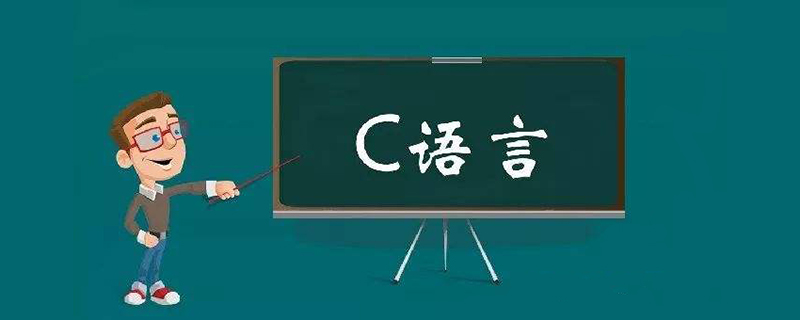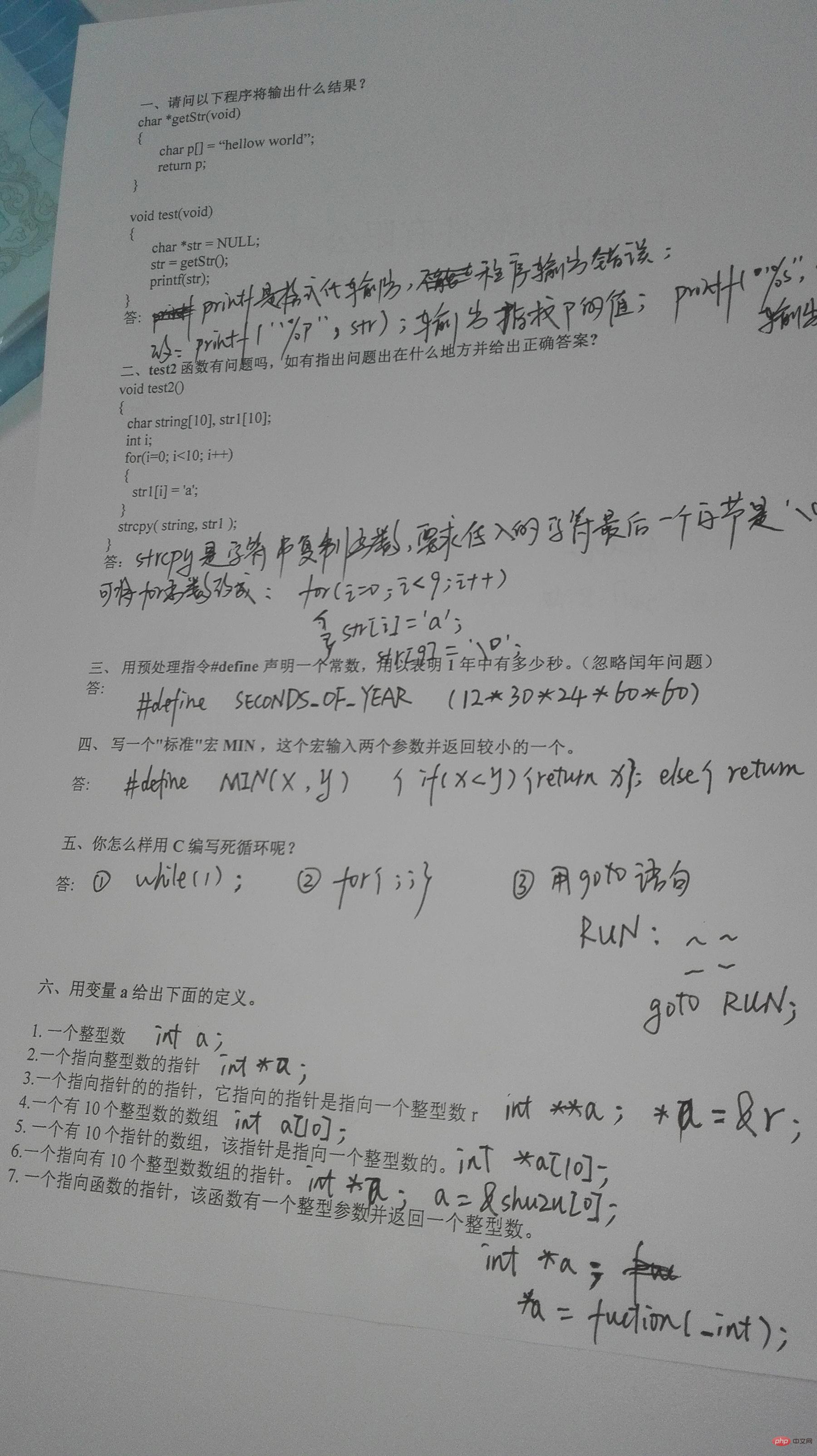 Backend Development
Backend Development
 C#.Net Tutorial
C#.Net Tutorial
 15 C language development interview questions (original questions shared)
15 C language development interview questions (original questions shared)
15 C language development interview questions (original questions shared)

The following are the written test questions for a software position in a company that focuses on Linux platform development that the subject participated in. I will share the original question and attach part of the reference answer for the subject's 91 points^V^)
1. (8 points) What result does the program output?
char *getStr(void)
{
char p[] = "hellow world";
return p;
}
void test(void)
{
char *str = NULL;
str = getStr();
printf(str);
}2. (5 points) Is there any problem with the test2 function? If so, please explain where the problem lies and give the correct answer.
void test2()
{
char string[10], str[10];
int i;
for(i = 0; i < 10; i++)
{
str[i] = 'a';
}
strcpy(string, str);
}3. (5 points) Use the preprocessing directive #define to declare a constant to indicate how many seconds there are in a year. (Ignore the leap year issue)
4. (5 points) Write a "standard" macro MIN, which takes two parameters and returns the smaller one.
5. (8 points) How do you write an infinite loop in C?
6. (10 points) Use variable a to give the following definition:
1. An integer;
2. A pointer to an integer;
3. A pointer to a pointer, the pointer it points to is an integer;
4. An array of 10 integers;
5 , an array of 10 pointers, which points to an integer;
6, a pointer to an array of 10 integers;
7, a pointer to a function A pointer, the function has an integer parameter and returns an integer;
8. An array of 10 pointers, the pointer points to a function, the function has an integer parameter and returns an integer Number;
7. (5 points) What is the function of the keyword static?
8. (10 points) What does the keyword const mean?
What do the following statements mean?
1) const int a;
2) int const a;
3) const int *a;
4) int *const a;
5) int const *a const;
9. (5 points) What is the output of the following code? Why?
void foo(void)
{
unsigned int a = 6;
int b = -20;
(a - b > 6) ? puts(">6") : puts("<=6");
}10. (5 points) What are the possible problems that may occur with dynamically allocated memory?
11. (5 points) What is the function of the keyword volatile?
12. (8 points) How many ways are there to communicate between processes? What are they?
13. (8 points) Please write the output result of the following program:
#include<stdio.h>
int main()
{
int a = 10, b, c, d;
b = a++;
c = ++a;
d = 10 * (++a);
printf(" b : %d , c:%d, d :%d ", b , c, d);
return 0;
}14. (5 points) What is the difference between a process and a thread?
15. (8 points) Please list the four bitwise operators and explain where they are generally used.
Part of the reference answer:

c Language Tutorial》
The above is the detailed content of 15 C language development interview questions (original questions shared). For more information, please follow other related articles on the PHP Chinese website!

Hot AI Tools

Undresser.AI Undress
AI-powered app for creating realistic nude photos

AI Clothes Remover
Online AI tool for removing clothes from photos.

Undress AI Tool
Undress images for free

Clothoff.io
AI clothes remover

AI Hentai Generator
Generate AI Hentai for free.

Hot Article

Hot Tools

Notepad++7.3.1
Easy-to-use and free code editor

SublimeText3 Chinese version
Chinese version, very easy to use

Zend Studio 13.0.1
Powerful PHP integrated development environment

Dreamweaver CS6
Visual web development tools

SublimeText3 Mac version
God-level code editing software (SublimeText3)

Hot Topics
 1376
1376
 52
52
 C language data structure: data representation and operation of trees and graphs
Apr 04, 2025 am 11:18 AM
C language data structure: data representation and operation of trees and graphs
Apr 04, 2025 am 11:18 AM
C language data structure: The data representation of the tree and graph is a hierarchical data structure consisting of nodes. Each node contains a data element and a pointer to its child nodes. The binary tree is a special type of tree. Each node has at most two child nodes. The data represents structTreeNode{intdata;structTreeNode*left;structTreeNode*right;}; Operation creates a tree traversal tree (predecision, in-order, and later order) search tree insertion node deletes node graph is a collection of data structures, where elements are vertices, and they can be connected together through edges with right or unrighted data representing neighbors.
 The truth behind the C language file operation problem
Apr 04, 2025 am 11:24 AM
The truth behind the C language file operation problem
Apr 04, 2025 am 11:24 AM
The truth about file operation problems: file opening failed: insufficient permissions, wrong paths, and file occupied. Data writing failed: the buffer is full, the file is not writable, and the disk space is insufficient. Other FAQs: slow file traversal, incorrect text file encoding, and binary file reading errors.
 What are the basic requirements for c language functions
Apr 03, 2025 pm 10:06 PM
What are the basic requirements for c language functions
Apr 03, 2025 pm 10:06 PM
C language functions are the basis for code modularization and program building. They consist of declarations (function headers) and definitions (function bodies). C language uses values to pass parameters by default, but external variables can also be modified using address pass. Functions can have or have no return value, and the return value type must be consistent with the declaration. Function naming should be clear and easy to understand, using camel or underscore nomenclature. Follow the single responsibility principle and keep the function simplicity to improve maintainability and readability.
 How to output a countdown in C language
Apr 04, 2025 am 08:54 AM
How to output a countdown in C language
Apr 04, 2025 am 08:54 AM
How to output a countdown in C? Answer: Use loop statements. Steps: 1. Define the variable n and store the countdown number to output; 2. Use the while loop to continuously print n until n is less than 1; 3. In the loop body, print out the value of n; 4. At the end of the loop, subtract n by 1 to output the next smaller reciprocal.
 CS-Week 3
Apr 04, 2025 am 06:06 AM
CS-Week 3
Apr 04, 2025 am 06:06 AM
Algorithms are the set of instructions to solve problems, and their execution speed and memory usage vary. In programming, many algorithms are based on data search and sorting. This article will introduce several data retrieval and sorting algorithms. Linear search assumes that there is an array [20,500,10,5,100,1,50] and needs to find the number 50. The linear search algorithm checks each element in the array one by one until the target value is found or the complete array is traversed. The algorithm flowchart is as follows: The pseudo-code for linear search is as follows: Check each element: If the target value is found: Return true Return false C language implementation: #include#includeintmain(void){i
 Troubleshooting tips for processing files in C language
Apr 04, 2025 am 11:15 AM
Troubleshooting tips for processing files in C language
Apr 04, 2025 am 11:15 AM
Troubleshooting Tips for C language processing files When processing files in C language, you may encounter various problems. The following are common problems and corresponding solutions: Problem 1: Cannot open the file code: FILE*fp=fopen("myfile.txt","r");if(fp==NULL){//File opening failed} Reason: File path error File does not exist without file read permission Solution: Check the file path to ensure that the file has check file permission problem 2: File reading failed code: charbuffer[100];size_tread_bytes=fread(buffer,1,siz
 C language multithreaded programming: a beginner's guide and troubleshooting
Apr 04, 2025 am 10:15 AM
C language multithreaded programming: a beginner's guide and troubleshooting
Apr 04, 2025 am 10:15 AM
C language multithreading programming guide: Creating threads: Use the pthread_create() function to specify thread ID, properties, and thread functions. Thread synchronization: Prevent data competition through mutexes, semaphores, and conditional variables. Practical case: Use multi-threading to calculate the Fibonacci number, assign tasks to multiple threads and synchronize the results. Troubleshooting: Solve problems such as program crashes, thread stop responses, and performance bottlenecks.
 Concept of c language function
Apr 03, 2025 pm 10:09 PM
Concept of c language function
Apr 03, 2025 pm 10:09 PM
C language functions are reusable code blocks. They receive input, perform operations, and return results, which modularly improves reusability and reduces complexity. The internal mechanism of the function includes parameter passing, function execution, and return values. The entire process involves optimization such as function inline. A good function is written following the principle of single responsibility, small number of parameters, naming specifications, and error handling. Pointers combined with functions can achieve more powerful functions, such as modifying external variable values. Function pointers pass functions as parameters or store addresses, and are used to implement dynamic calls to functions. Understanding function features and techniques is the key to writing efficient, maintainable, and easy to understand C programs.



)
